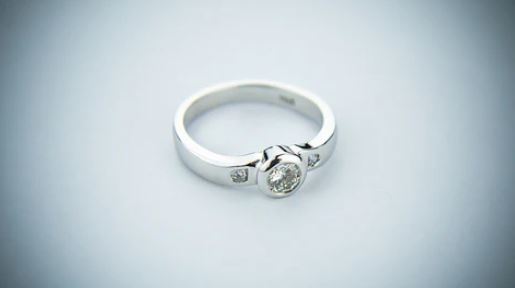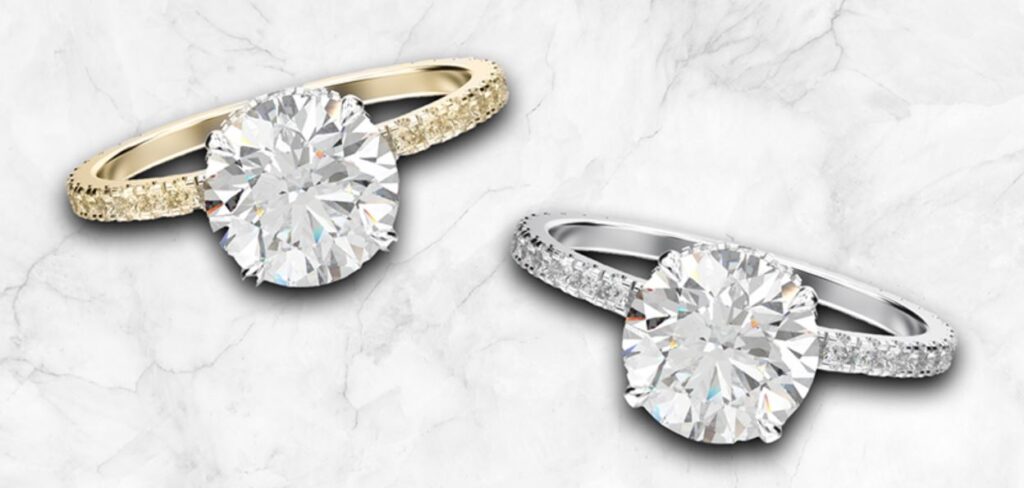Can You Shower with Sterling Silver
No, you can’t shower with sterling silver. Water can damage sterling silver jewelry and cause tarnishing. It also impacts the overall appearance and shine of your metal leading to polishing and extra cleaning. You should save sterling silver jewelry from all kinds of water damage or its overall life will be reduced.
In this article, we will explore can you shower with sterling silver, how water affects silver metal, and how to care for your jewelry to keep it looking shiny for years to come.
Why You Can’t Shower with Sterling Silver
Sterling silver is a blend of silver and copper. The standard composition for sterling silver is 92.5% pure silver and 7.5% copper by weight, which is why you’ll often see sterling silver stamped with a hallmark such as “925” or “92.5”.
The purpose of adding copper is to strengthen the silver, which on its own is soft and prone to scratching and bending. However, due to the addition of copper, sterling silver develops the properties of tarnishing. Sterling silver tarnishes when exposed to moisture, chemicals, and air. Tarnishing results in the metal turning dark or dull, which can detract from its beauty.
Here are some problems that you can face by regular contact of sterling silver jewelry with water.
Tarnishing
The main concern when it comes to water exposure is tarnishing. Copper, which is present in sterling silver, reacts with moisture and sulfur in the air, leading to discoloration. This tarnish layer appears as a dark, matte film over the silver’s surface, dulling its shine.
Soap Residue
Soap, shampoo, and conditioner can leave a film or residue on your jewelry, dulling its shine. Over time, this buildup can cause your sterling silver pieces to lose their luster and require more frequent cleaning.
Weakened Structure
Constant exposure to water and moisture can cause silver to become weaker over time, particularly in intricate designs or thinner pieces like chains. Over months or years, this can make the jewelry more prone to breakage.
Oxidation
Sterling silver can oxidize when exposed to moisture and air, leading to a darkened appearance. While some may appreciate the patina that comes with oxidation, others may prefer the shiny, new look of freshly polished silver.

What Happens If You Shower with Sterling Silver Regularly
Regularly showering with sterling silver can have several negative effects, some of which are irreversible. Over time, the jewelry may lose its original shine, become tarnished, or even weaken structurally. Here’s what you can expect if you frequently expose your sterling silver to water:
1. More Frequent Cleaning Needs
Regular exposure to water means you’ll need to clean your sterling silver jewelry more often to maintain its appearance. However, excessive cleaning, particularly with abrasive materials, can wear down the surface of the metal, leading to further damage.
2. Dullness
Water, combined with soap, minerals, and chemicals, can cause your sterling silver jewelry to become dull over time. Even if you try to clean it frequently, repeated exposure to moisture can result in a permanently faded appearance.
3. Tarnishing
Tarnish can occur faster if your sterling silver is regularly exposed to water, especially in high-humidity environments like bathroom, shower room or laundry room. This tarnish will cause the jewelry to lose its bright, reflective shine and develop a dark or yellowish hue. Note that tarnish can be removed by using tarnish removing chemicals but it increase the overall maintenance of the jewelry.
4. Structural Integrity
Prolonged water exposure can weaken delicate parts of your jewelry. Thin chains, prongs, or intricate designs may become more fragile over time, increasing the risk of breakage or damage.

How Different Water Types Affect Sterling Silver
While sterling silver is known for its durability, it’s important to note that water can negatively impact the metal over time. Water alone isn’t inherently harmful to sterling silver, but the elements present in most water sources can speed up the tarnishing process.
Tap Water
The main concern when it comes to water exposure is tarnishing. Copper, which is present in sterling silver, reacts with moisture and sulfur in the air, leading to discoloration. This tarnish layer appears as a dark, matte film over the silver’s surface, dulling its shine.
Hard Water
If the water in your area is considered “hard,” it contains higher concentrations of minerals like calcium and magnesium. These minerals can leave deposits on sterling silver, dulling its appearance and making it more challenging to maintain its luster.
Chlorine and Salt water
Exposure to chlorine, especially in swimming pools or cleaning products, is particularly harmful to sterling silver. Chlorine can cause corrosion, weakening the structure of the jewelry and contributing to tarnishing. Similarly, saltwater from oceans can accelerate the corrosion process, causing sterling silver to degrade over time.

How to Properly Care for Sterling Silver
To ensure that your sterling silver jewelry remains in pristine condition, it’s essential to follow proper care practices. Avoiding water exposure is just one part of maintaining your jewelry. Here are some additional care tips:
- Store Properly: Store your sterling silver in a dry, cool place. Use anti-tarnish bags or cloths, which help protect the metal from moisture and sulfur in the air. Avoid storing your jewelry in humid areas like bathrooms.
- Polish Regularly: Use a soft polishing cloth to buff your sterling silver jewelry and remove tarnish. This helps keep the metal shiny and reduces the need for more aggressive cleaning methods.
- Use Gentle Cleaners: If your sterling silver needs a deeper clean, use a gentle silver cleaner. Avoid harsh chemicals, which can cause corrosion or wear down the metal. You can also make a homemade solution using mild soap and water, but be sure to dry the jewelry thoroughly afterward.
- Remove Before Showering or Swimming: Make it a habit to remove your sterling silver jewelry before showering, swimming, or entering a sauna. This will significantly reduce the chances of tarnishing or other water-related damage.
- Avoid Harsh Chemicals: Keep your jewelry away from household cleaning products, perfumes, and lotions, all of which can contribute to tarnishing.
How to Restore Tarnished Sterling Silver
If your sterling silver jewelry has already tarnished, don’t worry. There are several methods to restore its shine:
Baking Soda and Aluminum Foil: Line a bowl with aluminum foil, add hot water and a few tablespoons of baking soda, and soak your silver jewelry. This creates a chemical reaction that helps lift the tarnish off the metal.
Silver Polish: Use a commercial silver polish specifically designed for sterling silver. Apply it with a soft cloth, gently rubbing the tarnished areas until they regain their shine.
Professional Cleaning: If your jewelry is heavily tarnished or damaged, it might be best to take it to a professional jeweler for cleaning and restoration.
Common FAQ’s about Shower with Sterling Silver
Here are some common FAQ’s.
1. Does water damage sterling silver in a single turn?
No, occasional contacts with water are not going to damage sterling silver. Only regular contacts will damage it.
2. What type of water is the most damaging for jewelry?
Chlorinated water and seawater are the most damaging type of water for sterling silver jewelry.
3. Should You save sterling silver from chemicals?
Yes, any type of chemicals including household chemicals like bleach, detergents and perfumes can damage it.
Conclusion
Showering with sterling silver damages the jewelry. It can become a cause of tarnishing, dull appearance and reduced life of your jewelry. Tarnishing can be removed by cleaning jewelry with tarnish removing chemicals but it will come at a cost. It is better to not wear sterling silver when you are near to water. It is often recommended to remove jewelry before tasks that involve water. Proper steps for caring of jewelry must be followed for its protection and beauty for time to come.

